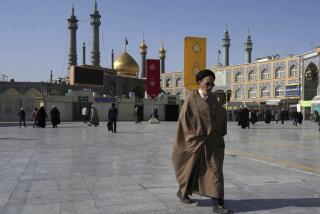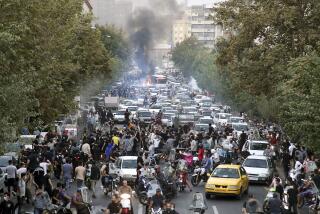Dread descends on Iraqi holy city
NAJAF, IRAQ — Clerics and politicians speak in hushed tones about the names drawn up for assassination. Guards stand outside their compounds clutching assault rifles, and handguns rest on desks. No one can be trusted. All sides fear that dark times are coming to Najaf, the spiritual capital of Iraq’s Shiite Muslims.
“The situation is mysterious,” said Sheik Ali Najafi, the son and confidant of Grand Ayatollah Bashir Hussain Najafi, one of the four senior most Shiite clerics in Iraq, who guide the country’s majority faith and counsel its politicians. Like elder statesmen, the four have found themselves ensnared in the conflict between the Shiite-led Iraqi government and an upstart young cleric, son of a revered grand ayatollah: Muqtada Sadr.
The poisonous atmosphere of treachery and paranoia has consequences far beyond the alleyways of this ancient shrine city.
Najaf may hold the key to Iraq’s stability; if it descends into violence, the entire Shiite south will almost certainly follow suit. U.S. forces will be stretched, the chances of a troop drawdown diminished. The Shiite parties involved will probably look to Iran to broker an end to the crisis. And chances for real political process will be on hold.
On Saturday night, the fears of a broader Shiite conflict loomed larger after Sadr threatened all-out war against the government if it did not halt military operations against his followers in Baghdad and the southern port of Basra.
Like Basra, with its oil, whoever controls Najaf will play a major role in charting Iraq’s future. It is here Shiite politicians come for guidance from the grand ayatollahs. It is here the populist Sadr first challenged Iraq’s conservative religious establishment.
“Najaf is the kitchen, where major decisions are cooked,” said Salah Obeidi, Sadr’s official spokesman.
Obeidi works out of a barren room in a closed-down restaurant and hotel. Bodyguards sit in the lobby, decorated with a mural of Sadr and long-haired Shiite saints gazing austerely at Najaf’s roads. Obeidi confesses he has been in crisis mode lately.
“We are afraid the situation from now till October won’t be stable for the Sadrists,” Obeidi said. “Najaf is very important.”
The city’s rewards are huge for Sadr and his competitors: lucrative revenues from the pilgrims who flock here, and the chance to spread one’s influence among the faithful.
Every year, millions of pilgrims come to Najaf to pray at the Imam Ali Mosque, the tomb of the prophet Muhammad’s son-in-law. It was over the question of Ali’s succession that the Shiite sect emerged. Believers from across Iraq bury their dead in Najaf’s cemetery, named the Valley of Peace. Aspiring clerics flock here to study at the revered hawza, a loose network of illustrious seminaries, rivaled only by Qom in Iran.
“Muqtada would covet the kind of Shiites Najaf holds,” said Vali Nasr, an expert on Shiite Islam at Tufts University. “Sadr is popular politically, the grand ayatollahs religiously. There is a tense standoff between them. They both hold power and popularity, and that is what makes the situation so tense and volatile.”
Najaf’s merchant elite and clergy have long viewed Sadr as a rabble rouser, able to mobilize the Shiite slums and rural masses for violence. No one in Najaf has forgotten April 2003, when Saddam Hussein fell and Sadr emerged from house arrest to lay claim to his dead father’s mantle. That month, Abdel Majid Khoei, the son of another late grand ayatollah, returned from London and was attacked by a mob inside the Imam Ali shrine, dying of his injuries near Sadr’s office.
Then, in the summer of 2004, Sadr seized the shrine as part of his open revolt against the Americans. The ensuing battle battered the city’s cemetery and neighborhoods. Even now, shattered buildings dot the landscape.
During that uprising, the country’s preeminent cleric, Grand Ayatollah Ali Sistani, intervened, offering Sadr’s Mahdi Army safe passage from the Imam Ali shrine as a way of ending a monthlong confrontation with the U.S. military.
This time, the grand ayatollahs have declined to aid the incendiary cleric.
Three days into the Basra campaign, Grand Ayatollah Najafi issued a fatwa, or religious opinion or edict, that declared the Iraqi government as the only force in the country with the right to bear arms.
His son, Sheik Ali Najafi, left little doubt that the clergy had backed the Iraqi army operations.
“We see this as a positive improvement. . . . The people want the government to control the streets and the law to be enforced. No other groups,” he said, sitting in his study, furnished with cushions, a laptop and a clock bearing his father’s portrait.
Their stance is a gamble. An influential cleric who is knowledgeable about talks between the Sadr movement and the grand ayatollahs described the situation in bleak terms: The government is weak, and Sadr aides now acknowledge privately that they have lost control of members who are receiving support from Iran.
“There are groups in the Mahdi Army who are kidnapping, killing and stealing. They don’t listen to Muqtada. They are openly operating with Iranian interests,” he said.
The cleric asked that his name not be used because he feared assassination. Everywhere, he saw Iran’s influence. “In the beginning, it was Arab countries playing a negative role. Now after Qaeda has fallen, it is Iran. Iran wants to control Iraq, and change the hawza from Najaf to Qom.”
Sadr’s loyalists are also fearful. The tensions between their mass movement and Najaf’s mainstream clergy are evident on the plaza of the Imam Ali tomb, where a yellow-brick building with a marble base rose two years ago. It is a museum for Sadr’s father, Grand Ayatollah Mohammed Sadeq Sadr, who was killed during Hussein’s rule.
A black banner flutters from the building for Riyadh Noori, a senior Sadr aide who was killed April 11 by gunmen waiting outside his house on a quiet suburban street here. Twenty to 30 young men stand outside in the evening air and study the worshipers heading to the shrine. People avert their eyes.
On a recent night, two gaunt men with scraggly beards hobbled into a Sadr office on crutches, one of them missing a leg, blown off fighting the Americans during Sadr’s 2004 uprising. The pair waited to meet Haidar Fakhrildeen, a lawmaker loyal to Sadr.
Fakhrildeen’s cellphone rang, playing a speech from Hezbollah leader Sheik Hassan Nasrallah about resistance and sacrifice. A black pistol sat on his desk. Like Obeidi, he said the movement expected more killings. Fakhrildeen spoke with a deep mistrust of the Americans and his Shiite political rivals: “Assassinations will happen because of the elections.”
The 6-foot-tall lawmaker also has to worry about Mahdi Army fighters co-opted by Tehran. “Iran interferes in everything,” he said. “It was able to control a handful of fighters to use them to serve their interests.”
In the meantime, life goes on in Najaf’s ancient bazaar. Merchants cut black and brown fabric for clerics’ robes. Families buy deep red pomegranate juice and ice cream for daughters in party dresses. But bazaar owners believe the calm might be fleeting. A bookseller, whose merchandise includes writings by Sistani and Sadr’s father, frowned.
“The quiet will not continue. There will be disorder,” he said confidentially between visits from customers who flipped through his books, with their pictures of the dour-faced clerics. He was sure the turbulence would pass: “After this unrest, there will be permanent stability.”
--
More to Read
Sign up for Essential California
The most important California stories and recommendations in your inbox every morning.
You may occasionally receive promotional content from the Los Angeles Times.










